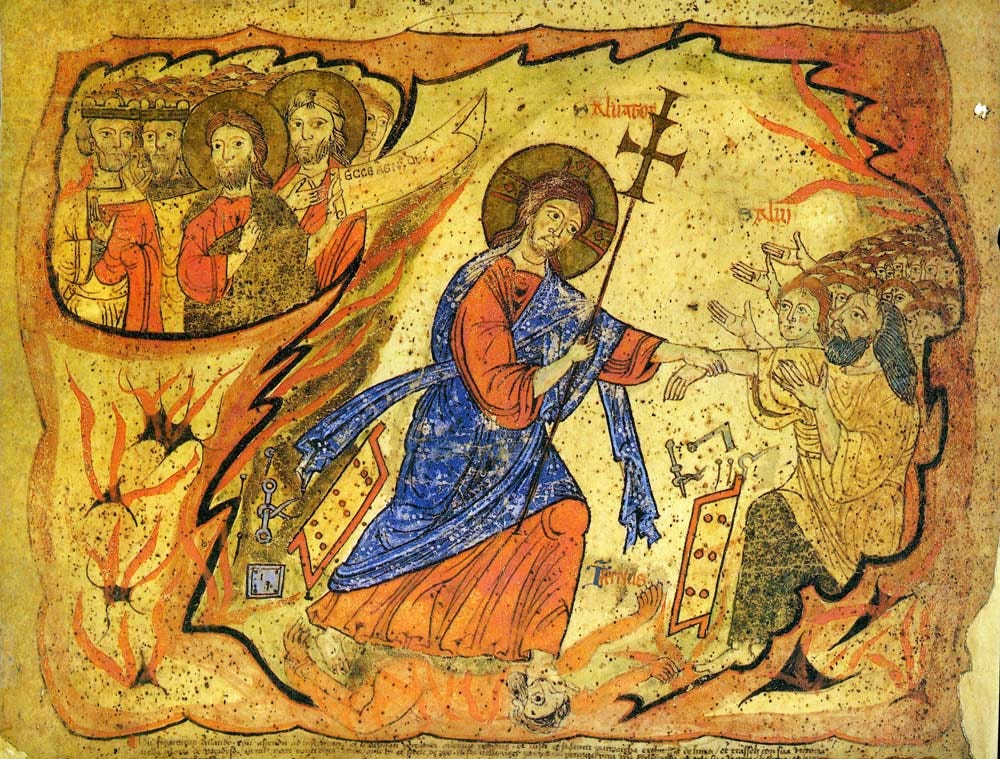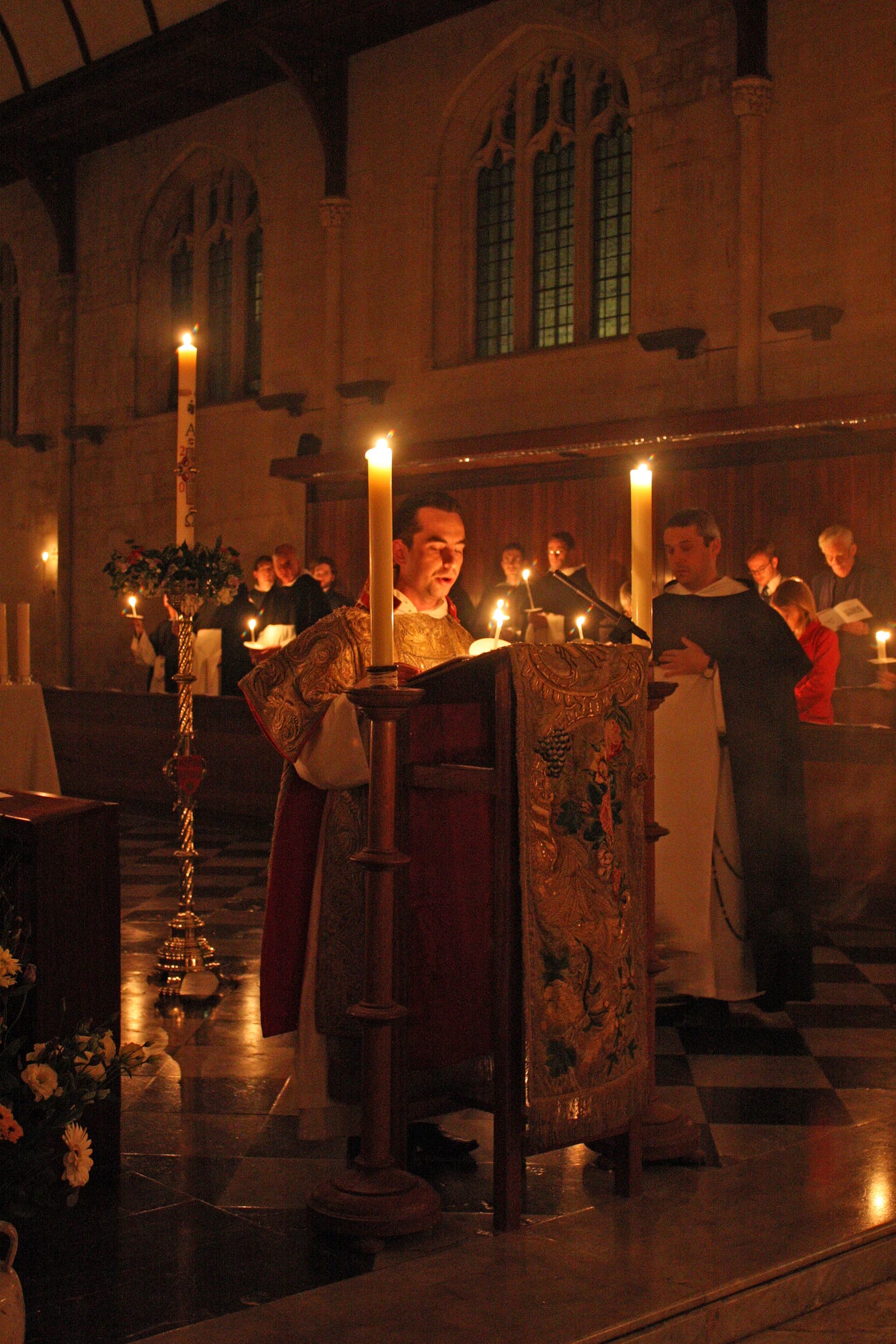Perhaps the single most beautiful piece of chant in the Catholic Church’s treasury is the Exsultet. It is so beautiful that the great Mozart himself once said that he would have gladly traded all his own works for the honour of having written the first line of the Exsultet. The chant is named after its first word, which translates to “rejoice.” The text of the Exsultet is too long for me to include in the body of this post; however, you can find an English translation below in the footnotes.1 In 1970, the new Roman Missal published a slightly shorter version of the Exsultet than the one provided below. The main difference between the newer version and the version that was used previously is the omission of the concluding prayer for the Holy Father and the bishop. For the most part, the exact same Exsultet is still used in the new Roman Missal.
Historians date the Exsultet to the late fourth century or the fifth century. Some experts conjecture that St. Ambrose (339-397 A.D.) wrote the Exsultet, although it is impossible to know this for certain. The chant was first used primarily in Catholic churches throughout Spain, France, and Italy; however, by the Carolingian Era in the eighth century, the Exsultet was included in Roman Rite liturgical books.

The Exsultet is a hymn of praise centered on the Paschal Candle, which represents the Risen Christ. The prologue of the hymn begins triumphantly, immediately calling on the “angelic choirs of Heaven” and the entire Church to rejoice. While the new Roman Missal permits a layperson to chant the Exsultet if a clergyman is unable to do so, the piece is traditionally sung by the deacon or, if no deacon is present, by the priest. The first part of the hymn thus contains the beautiful line, “[I]nvoke [with] me the mercy of almighty God. That He who has vouchsafed to admit me among the Levites, without any merits of mine, would pour forth the brightness of His light upon me, and enable me to perfect the praise of this wax candle.” This is the first reference to the Old Testament Exodus and Passover, preparing us for the next part of the chant, which expounds upon the connections between the Exodus and Easter Vigil.
After the first part of the Exsultet is concluded, the chant changes and adopts the style of a Preface, which is prayed before the Canon or Eucharistic Prayer at each Mass. This melodic change occurs to emphasize the importance of the words being sung. The second part of the Exsultet extols the Risen Christ, Who, “in this sacred night,” rose from the dead, “destroying the chains of death.” The hymn draws parallels between Christ’s rising from the dead on this night and God’s leading the Israelites out of Egypt by night. Just as the pillar of fire illuminated the dark night for the Israelites during their exodus out of Egypt, so too the Paschal Candle, symbolizing the Risen Christ, illuminates the dark church. The Easter Vigil is the night on which Christ dispelled the darkness of death with His eternal light.

In a uniquely medieval style, the Exsultet also praises the “truly needful sin of Adam, which was blotted out by the death of Christ! O happy fault, that merited to possess such and so great a Redeemer!” These lines may seem strange to modern listeners, as we are unaccustomed to hearing the sin of Adam and Eve be praised in such a way. However, this was a common theme in medieval theology, and its being included in the Exsultet gives us a chance to meditate on the theological truth behind these ancient words.
Here is a PDF from the Church Music Association of America containing the Gregorian Chant notation of the Exsultet. The wide range of high and low notes is immediately apparent at first glance. The range in the Exsultet makes it difficult to sing this piece well, and the melismas (multiple notes for one syllable) add to the complexity. When two notes appear on top of each other (called a podatus), the bottom note is sung first, with the top note flowing out of the accentuated first note. The small lines seen throughout the measures (which are denoted by single or double bar lines) indicate where to breathe in the measure. Since the Exsultet is not chanted by a choir or schola, staggered breathing is impossible. Thus, these breath marks indicate to the deacon or priest where he can take a breath as he sings.
Below is a recording of the Exsultet, sung according to the slightly longer form from the 1962 Roman Missal:
Bibliography
Clark, Richard J. “Helping Your Deacon or Priest Learn the Exsultet.” At Corpus Christi Watershed, 27 February 2015, at www.ccwatershed.org.
“Exsultet Iam Angelica Turba.” In New Catholic Encyclopedia, at www.encyclopedia.com.
“The Exsultet.” At Ampleforth Abbey, 29 March 2018, at www.ampleforthabbey.org.uk.
Flynn, Michael J. “The Exsultet: Christ Our Light.” At USCCB, www.usccb.org.
The Exsultet:
Let the angelic choirs of Heaven now rejoice; let the divine Mysteries rejoice; and let the trumpet of salvation sound forth the victory of so great a King. Let the earth also rejoice, made radiant by such splendor; and, enlightened with the brightness of the eternal King, let it know that the darkness of the whole world is scattered. Let our mother the Church also rejoice, adorned with the brightness of so great a light; and let this temple resound with the loud acclamations of the people. Wherefore I beseech you, most beloved brethren, who are here present in the wondrous brightness of this holy light, to invoke wtih me the mercy of almighty God. That He who has vouchsafed to admit me among the Levites, without any merits of mine, would pour forth the brightness of His light upon me, and enable me to perfect the praise of this wax candle. Through our Lord Jesus Christ His Son, Who with Him and the Holy Ghost liveth and reigneth one God for ever and ever. R. Amen.
V. The Lord be with you.
R. And with thy spirit.
V. Lift up thy hearts.
R. We have them lifted up to the Lord.
V. Let us give thanks to the Lord our God.
R. It is meet and just.
It is truly meet and right to proclaim with all our heart and all the affection of our mind, and with the ministry of our voices, the invisible God, the Father almighty, and His only-begotten Son our Lord Jesus Christ, who repaid for us to His eternal Father the debt of Adam, and by the merciful shedding of His Blood, cancelled the debt incurred by original sin. For this is the Paschal Festival; in which that true Lamb is slain, with Whose Blood the doorposts of the faithful are consecrated. This is the night in which Thou didst formerly cause our forefathers, the children of Israel, when brought out of Egypt, to pass through the Red Sea with dry foot. This, therefore, is the night which dissipated the darkness of sinners by the light of the pillar. This is the night which at this time throughout the world restores to grace and unites in sanctity those that believe in Christ, and are separated from the vices of the world and the darkness of sinners. This is the night in which, destroying the chains of death, Christ arose victorious from the grave. For it would have profited us nothing to have been born, unless redemption had also been bestowed upon us. O wondrous condescension of Thy mercy towards us! O inestimable affection of love: that Thou mightest redeem a slave, Thou didst deliver up Thy Son! O truly needful sin of Adam, which was blotted out by the death of Christ! O happy fault, that merited to possess such and so great a Redeemer! O truly blessed night, which alone deserved to know the time and hour when Christ rose again from hell! This is the night of which it is written: And the night shall be as clear as the day; and the night is my light in my delights. Therefore the hallowing of this night puts to flight all wickedness, cleanses sins, and restores innocence to the fallen, and gladness to the sorrowful. It drives forth hatreds, it prepares concord, and brings down haughtiness.
Wherefore, in this sacred night, receive, O holy Father, the evening sacrifice of this incense, which holy Church renders to Thee by the hands of Thy ministers in the solemn offering of this wax candle, made out the work of bees. Now also we know the praises of this pillar, which the shining fire enkindles to the honor of God. Which fire, although divided into parts, suffers no loss from its light being borrowed. For it is nourished by the melting wax, which the mother bee produced for the substance of this precious light. O truly blessed night, which plundered the Egyptians and enriched the Hebrews! A night in which heavenly things are united to those of earth, and things divine to those which are of man.
We beseech Thee, therefore, O Lord, that this wax candle hallowed in honor of Thy Name, may continue to burn to dissipate the darkness of this night. And being accepted as a sweet savor, may be united with the heavenly lights. Let the morning star find its flame alight. That star, I mean, which knows no setting. He Who returning from hell, serenely shone forth upon mankind. We beseech Thee therefore, O Lord, that Thou wouldst grant peaceful times during this Paschal Festival, and vouchsafe to rule, govern, and keep with Thy constant protection us Thy servants, and all the clergy, and the devout people, together with our most holy Father, Pope N., and our Bishop N.. Have regard, also, for those who reign over us, and, grant them Thine ineffable kindness and mercy, direct their thoughts in justice and peace, that from their earthy toil, they may come to their heavenly reward with all Thy people. Through the same Jesus Christ, Thy Son, our Lord, who with Thee liveth and reigneth in the unity of the Holy Ghost, God: World without end. R. Amen.




It’s just so brilliant of a chant. If you ever look at the pre-1955 Easter Vigil, the rubrics actually have a fair amount of actions being performed to the candle while singing it and even presume that these actions are being performed in the context of the chant. Breathtakingly beautiful.
I had to sing it a couple of times in the 70's, but in English.